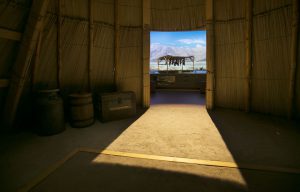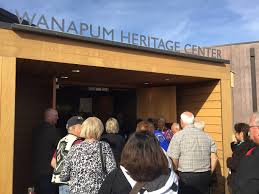Wanapum Heritage Center – Beverley, WA
BEVERLEY, Wash. – The Wanapum (river people) once thrived along a stretch of the Columbia river, they were a peace loving tribe that did not fight wars with the U.S. government, and therefore required no treaty. Their desire for peace left them without a land base, they are virtually extinct.
Though their numbers are decimated, they persist in a rough country of sagebrush and bunchgrass, within a landscape drastically altered by the whites. Part of their story is enshrined in the small but enriching Wanapum Heritage Center.
The Theater
The Heritage center installed a complete Bag End system in its presentation theater. The system was designed by CPS Electronics and features three CDS-110 full range systems for left, center and right. The full range systems are located behind the acoustically transparent screen. In addition, TA80-IY‘s were used for rear surround effects. Furthermore, the mainstay of Bag End’s subwoofer line, the D18E-I, provides deep bass like no other subwoofer can.
The Lobby
In the lobby sits a 29-foot canoe that Puck Hyah Toot, a prophet and religious leader, carved with the Tomanawash brothers in the 1800’s. The Wanapum people made canoes from driftwood provided by Chiawana, the Great River of life and myth, now called the Columbia. In addition, the Chiawana is where salmon that provided sustenance once flourished.
The Collection
The collection includes leather, cloth, beaded and woven items that belonged to Martha Johnny, the daughter of Puck Hyah Toot, nephew of spiritual leader Smowhalla. Some are her handiwork, some she purchased; others are keepsakes, handed down to her or acquired through trade. There are also samples of exquisitely crafted implements, such as spoons made from mountain goat horn, bone antlers, wooden needles, delicate arrowheads and various tools made from the basalt rock prolific in the area. The items represent a portion of the collection secured in a repository located in the bowels of Wanapum Dam adjacent to the heritage center. Tule mat longhouses can be seen in historic photos and in the models, along with small samples of weaving’s.
Wanapum’s existence was threatened when their village was to be flooded due to construction of a dam at Priest Rapids. Negotiations with the Grant PUD resulted in relocation to their current settlement just west of the dam. The PUD, Wanapum, several government agencies and the University of Washington cooperated in an “archaeological salvage” operation before the flooding. A portion of this operation entailed blasting ancient petroglyphs from sites along the river and removing them to the Ginkgo Petrified Forest near Vantage.The Wanapum dreamer prophet, Smowhalla predicted the cataclysmic changes of the past 150 years. A few changes in the area are addressed in the museums’ displays, such as the introduction of steamboats on the Columbia, mining and great cattle herds introduced to supply food to teeming Northwest mining camps.
The Heritage Center is intended to protect preserve and perpetuate the culture traditions and identity of the Wanapum of Priest Rapids. It is located on the ancestral grounds of the Wanapum. The 50,000 sq ft facility houses a 10,000 sq ft permanent exhibit space, a 2,000 sq ft temporary rotating exhibit space, a climate controlled repository and collection facility, a library, staff offices and open space for large group activities conferences, demonstrations, training and living culture program activities.


